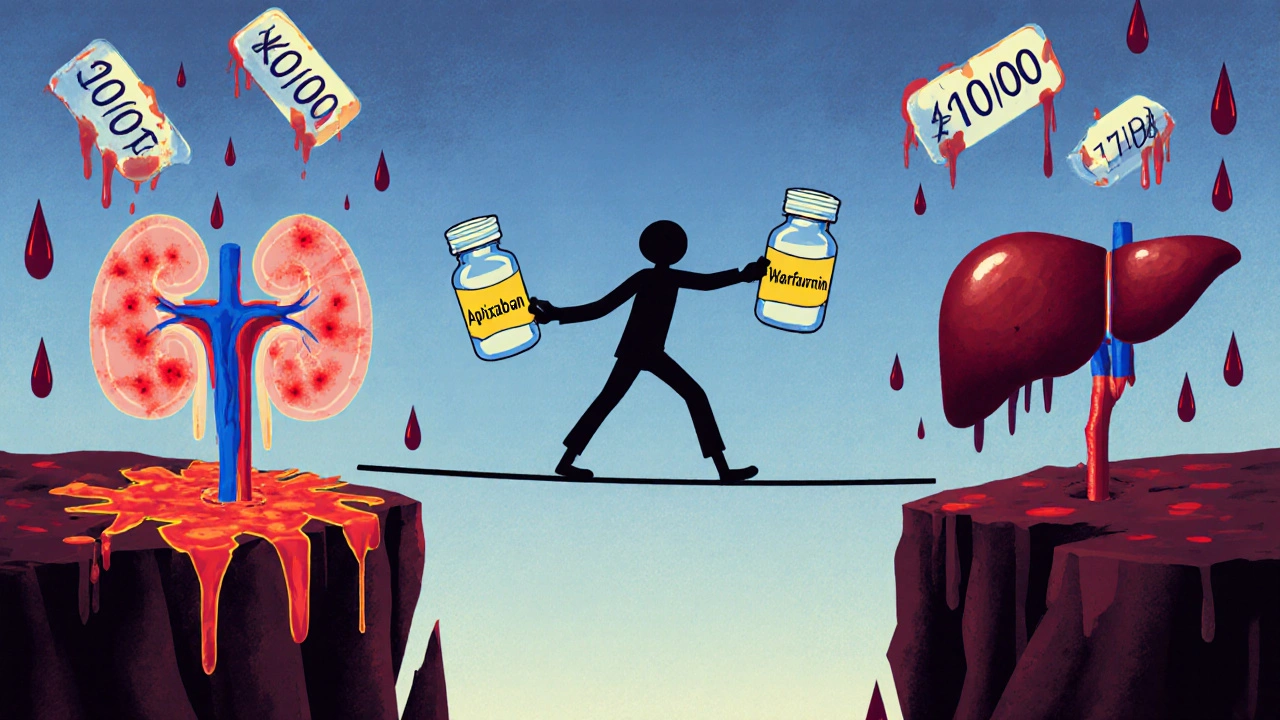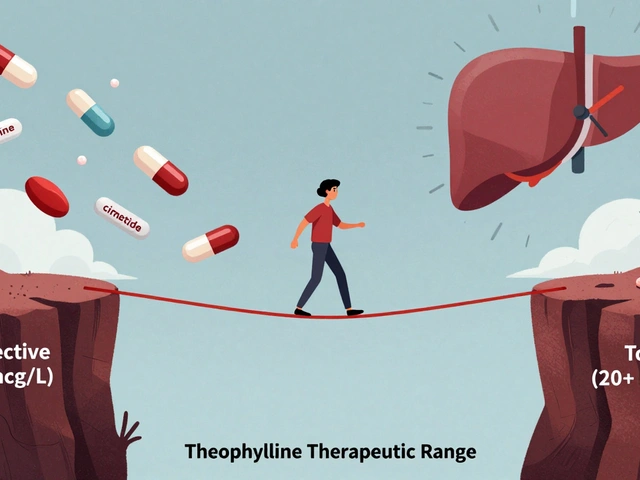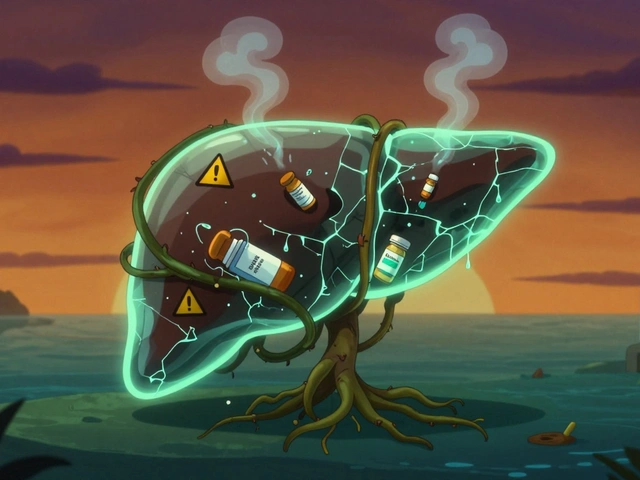
Anticoagulation Dosing Calculator
Patient Assessment
Recommendations
Enter patient information to see dosing recommendations.
Why Anticoagulation Gets So Complicated in Kidney and Liver Disease
When someone has both kidney disease and liver disease, taking a blood thinner isn’t like taking a daily pill for high blood pressure. It’s a tightrope walk. Too little anticoagulation, and they could have a stroke or a clot in their liver or kidneys. Too much, and they could bleed out internally-no warning, no second chance. This isn’t theoretical. In the U.S., over 37 million people have chronic kidney disease, and nearly 6 million have chronic liver disease. About one in four people with atrial fibrillation have one or both. And yet, most of the big drug trials that approved today’s blood thinners deliberately left these patients out.
How Kidney Disease Changes the Rules for Blood Thinners
Your kidneys don’t just filter waste-they clear drugs from your body. When kidney function drops, anticoagulants build up. That’s why dose adjustments aren’t optional; they’re life-saving.
For patients with mild to moderate kidney disease (eGFR 45 mL/min or higher), most direct oral anticoagulants (DOACs) like apixaban, rivaroxaban, and edoxaban can be used at standard doses. But once eGFR falls below 45, things change fast.
Apixaban is the most forgiving. Even at eGFR as low as 15 mL/min, it’s still used at 2.5 mg twice daily. Why? Because only about 27% of it is cleared by the kidneys. The rest gets broken down by the liver. Rivaroxaban? About a third leaves through the kidneys. Dabigatran? Eighty percent. That’s why dabigatran is banned in severe kidney disease-it piles up dangerously.
For patients on dialysis, the data is messy. Some doctors avoid DOACs entirely. Others use apixaban 2.5 mg twice daily, based on real-world outcomes showing fewer bleeds than warfarin. A 2021 registry of over 12,000 dialysis patients found those on DOACs had 23% fewer major bleeds than those on warfarin. But stroke rates were about the same. That’s the trade-off: less bleeding, but no proven extra protection against clots.
Warfarin is still common in dialysis patients-not because it’s better, but because we know how to reverse it. Vitamin K and fresh frozen plasma can undo its effects. But here’s the catch: warfarin’s INR numbers become unreliable in advanced kidney disease. A patient might have an INR of 2.5 and still be under-anticoagulated, or an INR of 3.2 and be bleeding. That’s why many nephrologists now check INR twice a month instead of once.
Liver Disease: When Your Blood Doesn’t Know How to Clot
The liver doesn’t just process drugs-it makes the proteins that help your blood clot. In cirrhosis, that production crashes. You get low platelets, low clotting factors, and a liver that can’t clear anticoagulants. So you’re stuck between two risks: clots forming in your liver’s veins, or bleeding into your gut or brain.
The Child-Pugh score is the go-to tool. Class A (mild) cirrhosis? DOACs are often okay at normal doses. Class B (moderate)? Proceed with caution. Class C (severe)? Don’t use DOACs. A 2017 study found patients with Child-Pugh C had more than five times the risk of major bleeding on DOACs compared to those with healthy livers.
Warfarin? It’s a nightmare here too. INR doesn’t reflect the full picture. A high INR in cirrhosis doesn’t mean you’re over-anticoagulated-it might just mean your liver is failing. Some hepatologists use thromboelastography (TEG) or ROTEM, which measure how blood actually clots in real time. But only about 38% of U.S. hospitals have these tools.
One doctor told a colleague: “I don’t treat the INR. I treat the patient.” If someone has a platelet count below 50,000 or a MELD score above 20, many will stop anticoagulation altogether-even if they have atrial fibrillation. The risk of bleeding just outweighs the benefit.

DOACs vs. Warfarin: The Real Numbers
Let’s cut through the noise. What do the numbers actually say?
- In patients with moderate kidney disease (eGFR 25-30), apixaban cuts major bleeding risk by 31% compared to warfarin.
- DOACs reduce intracranial bleeding by 62% in CKD patients-big win.
- But in end-stage kidney disease, that advantage fades. For patients with mechanical heart valves, warfarin is still the standard. DOACs aren’t approved here at all.
- In liver disease, DOACs reduce bleeding compared to warfarin in Child-Pugh A, but data is too thin for B and C.
- Warfarin’s big flaw? Only 45% of cirrhotic patients stay in the therapeutic range. Healthy patients hit 65%.
What Doctors Actually Do in Real Life
Guidelines are nice. Reality is messy.
In a 2021 study of dialysis patients with atrial fibrillation, only 28% got any anticoagulation-even though 76% had a high stroke risk score. Why? Fear. Fear of bleeding. Fear of lawsuits. Fear of not knowing what to do.
One nephrologist on Reddit shared that over two years, he gave apixaban 2.5 mg daily to 15 dialysis patients. None bled. Another described a patient who died from a retroperitoneal hemorrhage after starting apixaban. Same drug. Same dose. Same disease. One worked. One didn’t. That’s the problem: we don’t know who will respond safely.
For liver disease, hepatologists are increasingly checking platelet function-not just count. A platelet count of 80,000 might be fine. But if those platelets don’t stick together well? That’s a red flag. One study found 42% of hepatologists change anticoagulation based on platelet function tests.

Reversal Drugs: Hope, But Not Always Available
What if someone starts bleeding? Can we undo the blood thinner?
For dabigatran: idarucizumab (Praxbind®). Costs $3,500 per dose. Works fast. But only for dabigatran.
For rivaroxaban and apixaban: andexanet alfa (Andexxa®). Costs $19,000 per dose. Only available in 45% of U.S. hospitals. And even then, it’s not always on the shelf.
Warfarin? Vitamin K and plasma. Cheap. Widely available. But slow. Takes hours to work.
In a crisis, the difference between life and death might be whether your hospital has andexanet alfa in the fridge. And most don’t.
The Bottom Line: No Perfect Answer, But Better Choices
There’s no one-size-fits-all rule. But here’s what most experts agree on:
- If you have mild kidney disease (eGFR ≥45), apixaban or rivaroxaban are safe and better than warfarin.
- If you have moderate kidney disease (eGFR 30-44), use apixaban 2.5 mg twice daily. Avoid dabigatran.
- If you’re on dialysis, apixaban 2.5 mg twice daily is the most supported option. Avoid rivaroxaban and edoxaban.
- If you have Child-Pugh A cirrhosis, DOACs are reasonable. Avoid them in Child-Pugh B or C.
- Never use DOACs for mechanical heart valves-warfarin is still the only approved option.
- Monitor kidney and liver function every 3 months. More often if things are unstable.
- When in doubt, consult a hematologist, nephrologist, and hepatologist together. This isn’t a solo decision.
What’s Coming Next?
Two major studies are underway. The MYD88 trial is comparing apixaban to warfarin in 500 dialysis patients-results expected in 2025. The LIVER-DOAC registry is tracking over 1,200 cirrhotic patients on DOACs worldwide. And the FDA is considering new labeling for apixaban in end-stage kidney disease based on new modeling data.
KDIGO is updating its guidelines in late 2024. That’s when we might finally get clearer, evidence-backed recommendations.
For now, the answer isn’t about which drug is best. It’s about which drug is least dangerous-for this patient, right now.
Can you use apixaban in patients on dialysis?
Yes, apixaban 2.5 mg twice daily is the most commonly used and best-supported DOAC for dialysis patients. It’s not FDA-approved for this use, but multiple real-world studies show it’s safer than warfarin with fewer major bleeds. Other DOACs like rivaroxaban and edoxaban are not recommended due to higher bleeding risk. Dabigatran is contraindicated.
Why is warfarin still used if DOACs are better?
Warfarin is still used because we know how to reverse it quickly with vitamin K and plasma. DOAC reversal drugs like andexanet alfa are expensive and not available everywhere. In emergencies-especially in small hospitals-warfarin gives doctors a safety net. Also, for mechanical heart valves, warfarin is the only approved option.
Is INR reliable in liver disease?
No. INR only measures vitamin K-dependent clotting factors, but in liver disease, many other clotting proteins are low too. A high INR might mean the liver is failing, not that the patient is over-anticoagulated. Some centers use TEG or ROTEM to get a full picture of clotting ability, but these tests aren’t widely available.
What’s the safest DOAC for someone with both kidney and liver disease?
Apixaban is generally the safest choice. It has the lowest renal clearance (only 27%), so it’s less affected by poor kidney function. It’s also less dependent on liver metabolism than rivaroxaban or edoxaban. But if liver disease is severe (Child-Pugh B or C), even apixaban carries high bleeding risk. Always involve a specialist team before starting.
When should you stop anticoagulation in cirrhosis?
Many experts recommend stopping if platelet count falls below 50,000/μL or MELD score exceeds 20. These are signs of advanced liver failure and high bleeding risk. For patients with portal vein thrombosis, anticoagulation may still be needed-but that’s a different risk-benefit calculation than for atrial fibrillation.
Are there any new blood thinners coming for kidney or liver patients?
No new anticoagulants are approved yet, but two major studies are underway. The MYD88 trial is testing apixaban vs. warfarin in dialysis patients and will finish in 2025. The LIVER-DOAC registry is collecting data on cirrhotic patients on DOACs. Updated guidelines from KDIGO and the FDA are expected in late 2024, which may lead to new labeling or recommendations.






9 Comments
This is one of those posts that makes you feel like you finally got a peek behind the curtain. 🙌 I work in a small clinic in Rajasthan, and we get so many CKD + AFib cases. Apixaban 2.5 mg BID is our go-to now - and honestly, it’s saved more than a few lives. No fancy reversal drugs here, but we’ve had zero bleeds in 18 months. Grateful for posts like this./p>
Wait… so you’re saying we just… guess? No RCTs? No clear guidelines? And we’re just… giving people life-or-death meds based on ‘real-world data’? 🤦♂️. This isn’t medicine. It’s roulette with a stethoscope./p>
I just want to say thank you for writing this with so much humanity. I’m a nurse in a dialysis unit, and I’ve seen patients terrified to even take a pill because they’re afraid they’ll bleed out. This isn’t just clinical - it’s emotional. The fact that you mentioned fear as a real barrier? That’s the truth we don’t talk about enough./p>
Dabigatran bad, apixaban good… whatever. I heard one doc say ‘it’s all just chemistry anyway’ and i was like… yeah but why do we even have 5 different drugs if they all do the same thing? 🤷♂️ also who even uses TEG? sounds like a typo for ‘teg’ like the shoe brand./p>
OMG I just shared this with my mom who’s on dialysis and has AFib. She cried. Not because she’s scared - because someone finally explained it without sounding like a textbook. I’m sending this to her nephrologist. Also, can we get a meme about ‘INR is a lie’? I’d share it on Insta./p>
This post is dangerously oversimplified. You cite ‘real-world data’ like it’s gospel. Real-world data is garbage without RCTs. And you’re recommending apixaban in dialysis? That’s off-label. That’s malpractice waiting to happen. If you’re not following FDA labeling, you’re not a doctor - you’re a gambler./p>
I work with liver patients daily. The moment someone says ‘INR is unreliable’ - I breathe a sigh of relief. Because for so long, we were chasing numbers instead of people. One patient had an INR of 4.8 but was perfectly fine. Another had an INR of 2.1 and bled out. The difference? Platelet function. We started using PFA-100. Life changed. This isn’t about drugs. It’s about listening./p>
I’m just saying… if you’re giving apixaban to someone with Child-Pugh C… and they bleed… you’re gonna be on the news. And your name will be in the lawsuit. And your hospital will blame you. And your family will see it. So… good luck. 😭/p>
The core tension here isn't pharmacological - it's epistemological. We're operating in a space where evidence is sparse, but consequences are absolute. The medical paradigm demands certainty, yet the biology refuses to comply. In this liminal space, we are not practitioners of science - we are stewards of uncertainty. Apixaban, in this context, is less a drug and more a ritual of cautious hope. We administer it not because we know it works, but because we cannot bear to do nothing./p>